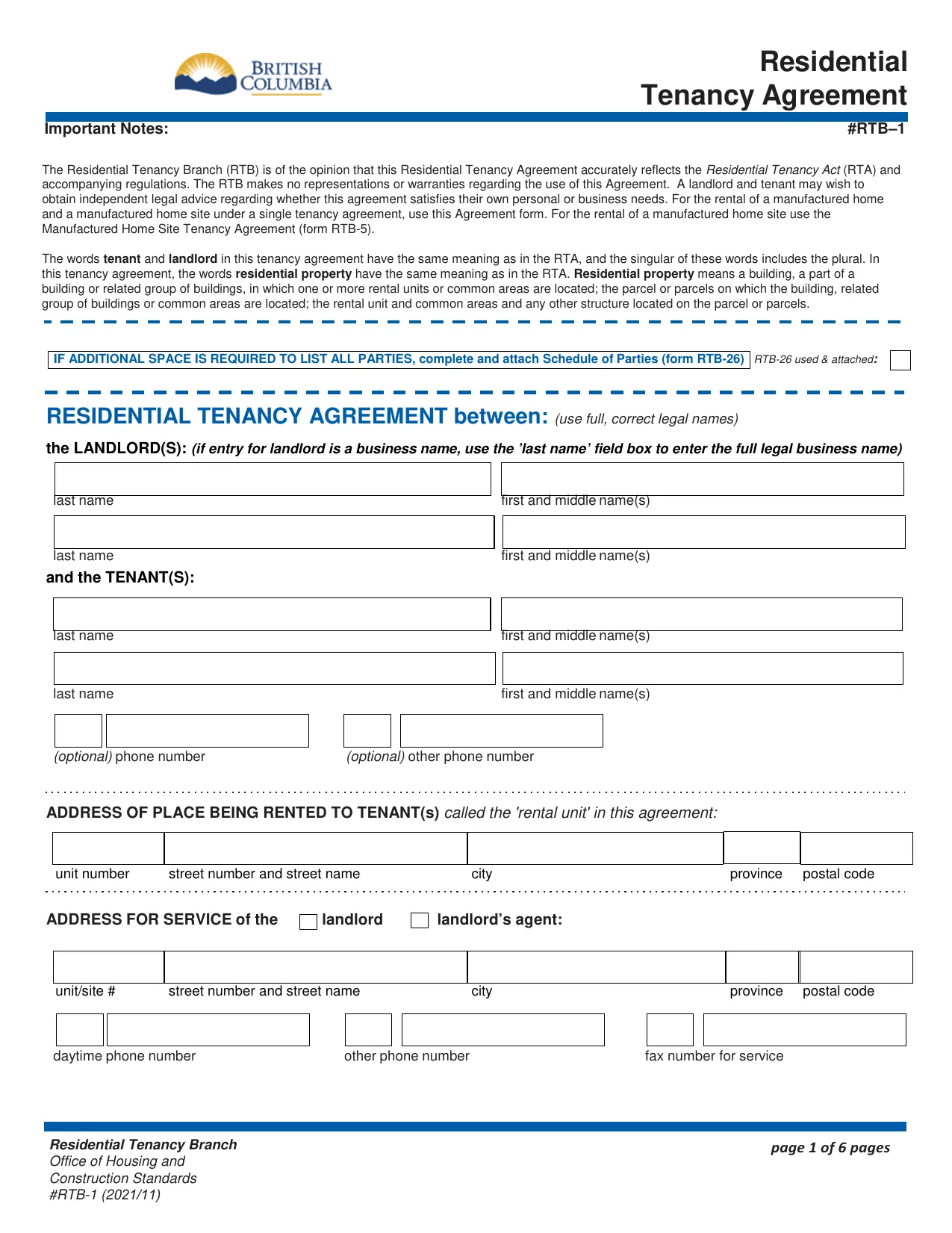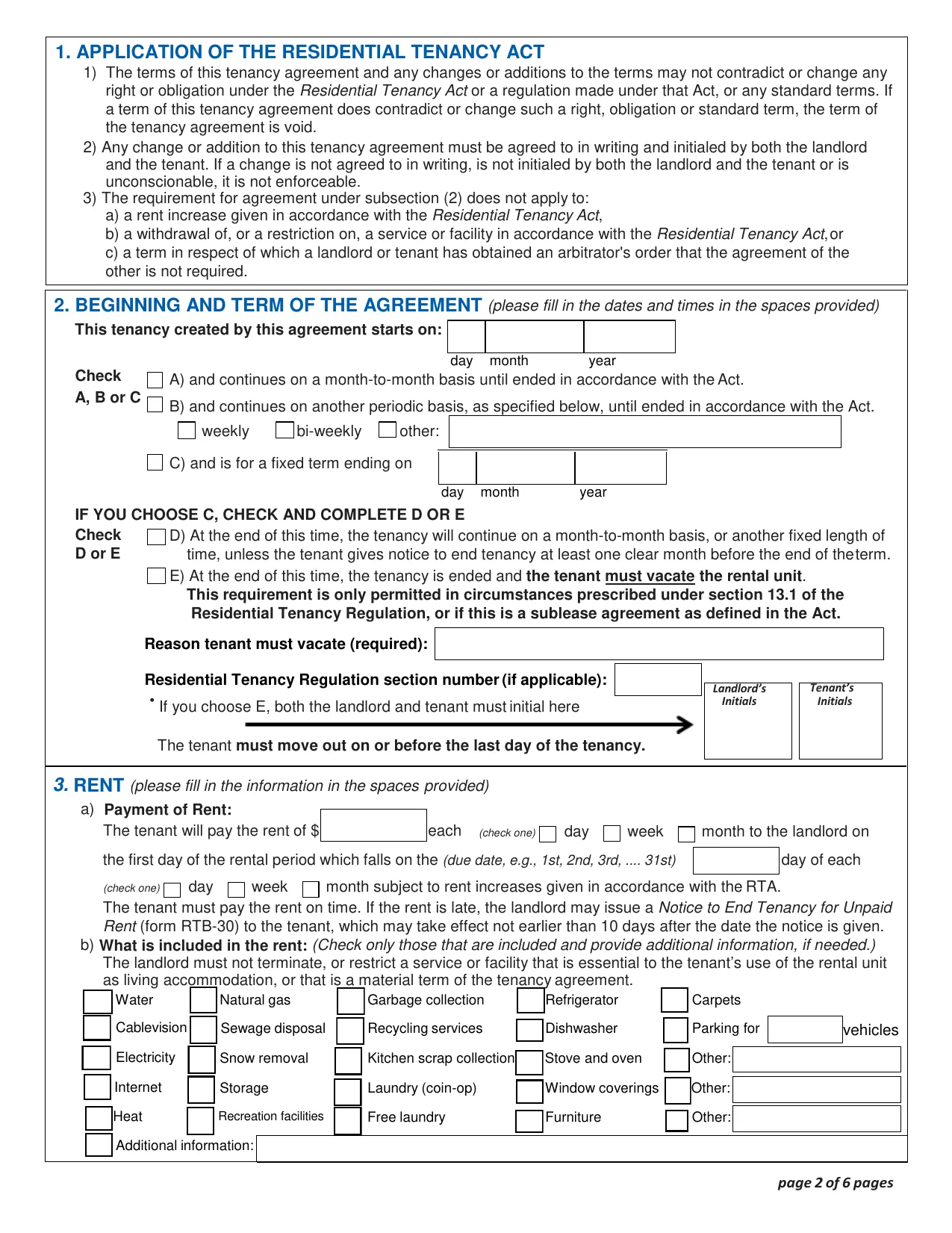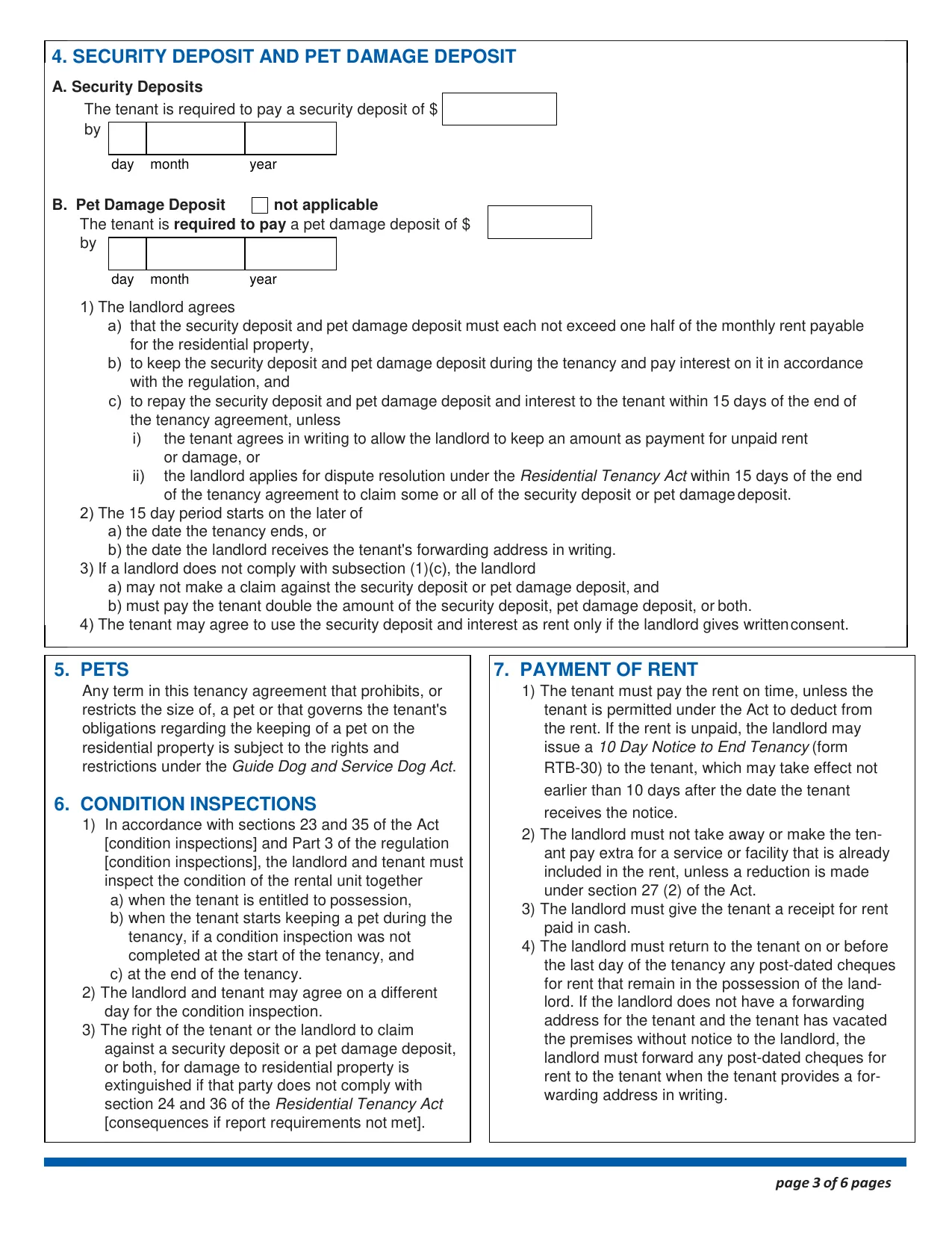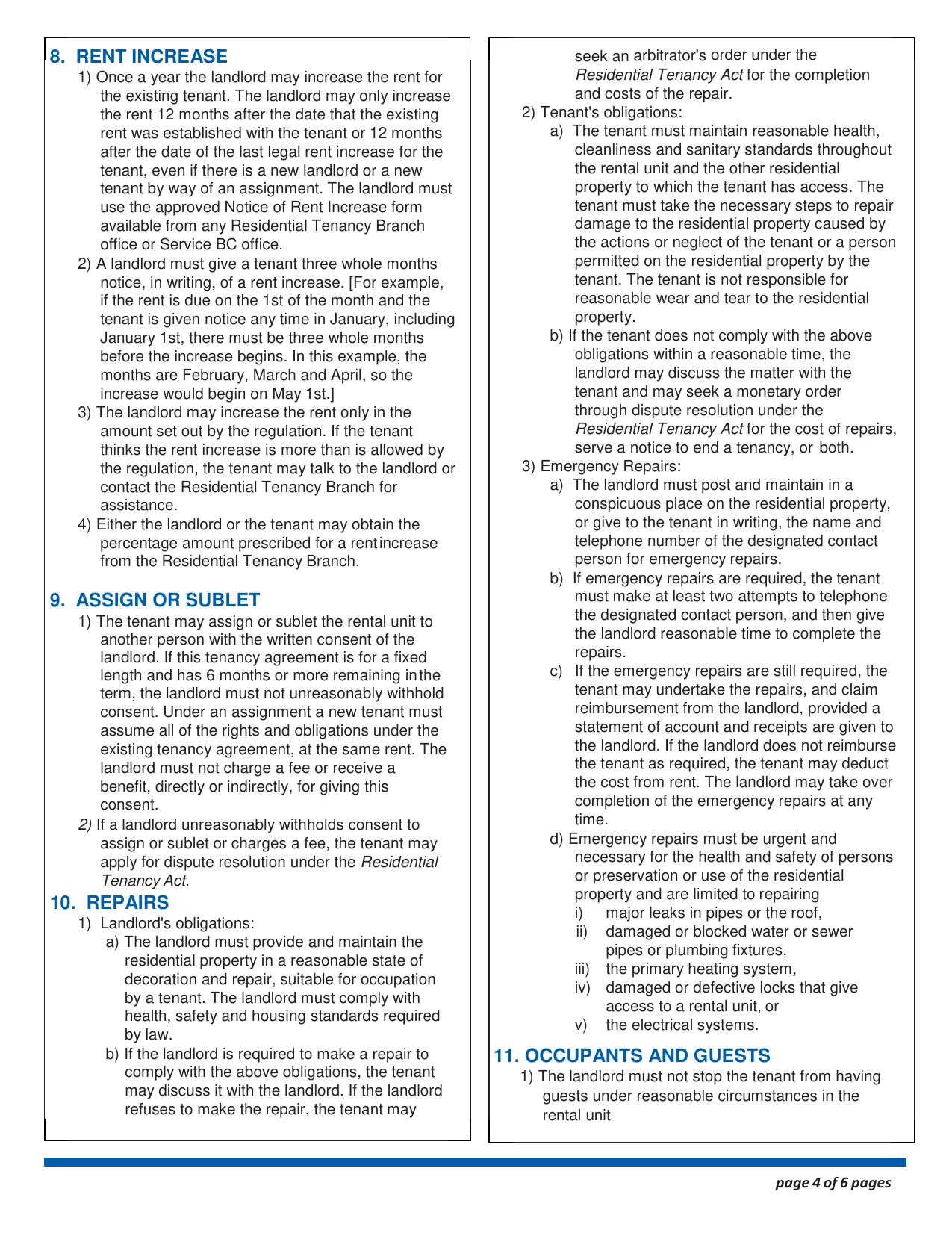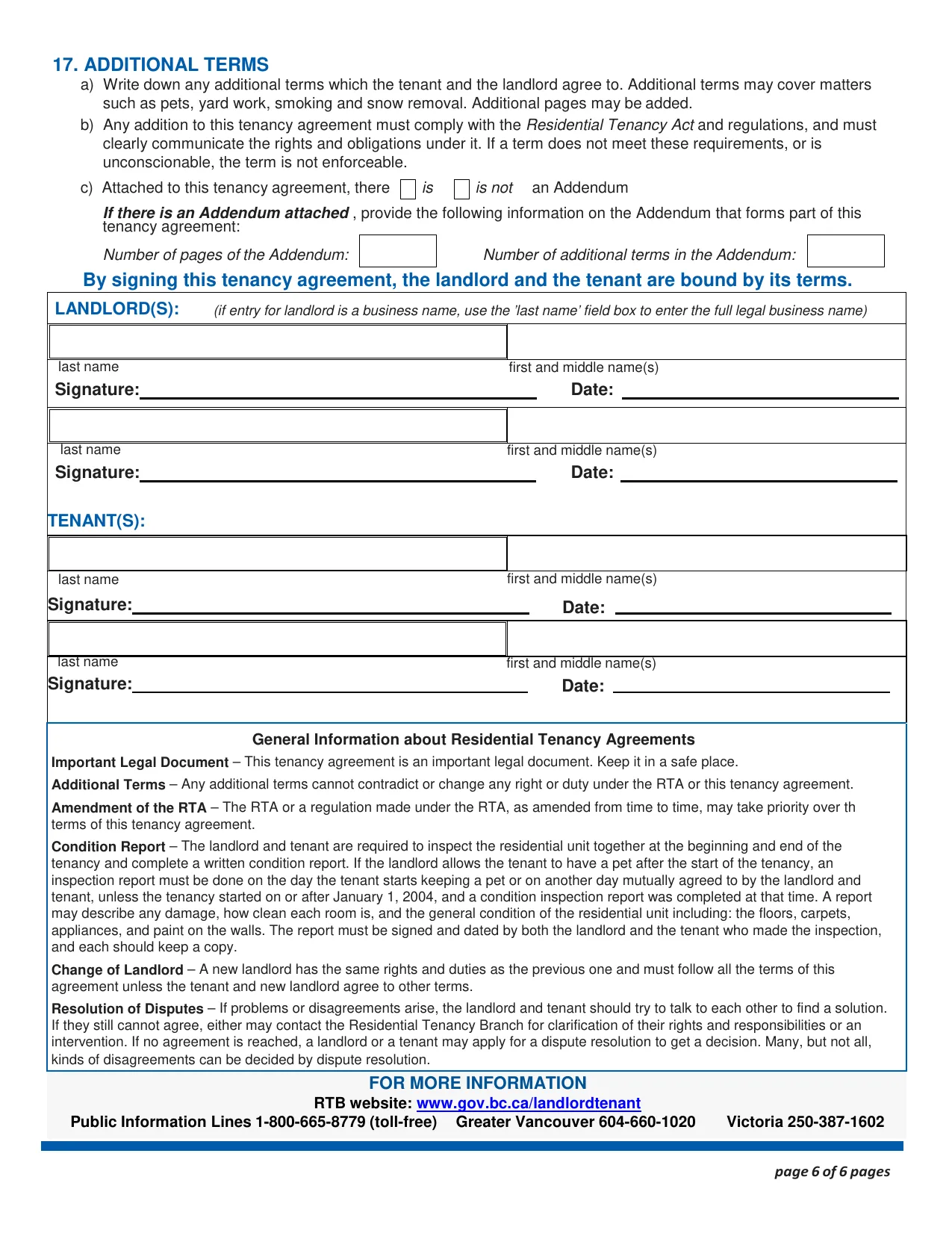BC Tenancy Agreement - Fill, Sign Online, Download & Print - No Signup
Residential
Tenancy Agreement
Important Notes:
#RTB–1
The Residential Tenancy Branch (RTB) is of the opinion that this Residential Tenancy Agreement accurately reflects the
Residential Tenancy Act
(RTA) and
accompanying regulations. The RTB makes no representations or warranties regarding the use of this Agreement. A landlord and tenant may wish to
obtain independent legal advice regarding whether this agreement satisfies their own personal or business needs. For the rental of a manufactured home
and a manufactured home site under a single tenancy agreement, use this Agreement form. For the rental of a manufactured home site use the
Manufactured Home Site Tenancy Agreement (form RTB-5).
The words
tenant
and
landlord
in this tenancy agreement have the same meaning as in the RTA, and the singular of these words includes the plural. In
this tenancy agreement, the words
residential property
have the same meaning as in the RTA.
Residential property
means a building, a part of a
building or related group of buildings, in which one or more rental units or common areas are located; the parcel or parcels on which the building, related
group of buildings or common areas are located; the rental unit and common areas and any other structure located on the parcel or parcels.
RTB-26 used & attached
:
RESIDENTIAL TENANCY AGREEMENT between:
(use full, correct legal names)
the LANDLORD(S):
(if entry for landlord is a business name, use the ’last name’ field box to enter the full legal business name)
last name
first and middle name(s)
last name
first and middle name(s)
and the TENANT(S):
last name
first and middle name(s)
last name
first and middle name(s)
(optional)
phone number
(optional)
other phone number
ADDRESS OF PLACE BEING RENTED TO TENANT(s)
called the 'rental unit' in this agreement:
unit number
street number and street name
city
province
postal code
ADDRESS FOR SERVICE of the
landlord
landlord’s agent:
unit/site #
street number and street name
city
province
postal code
daytime phone number
other phone number
fax number for service
Residential Tenancy Branch
Office of Housing and
Construction Standards
#RTB-1 (2021/11)
page 1 of 6 pages
IF ADDITIONAL SPACE IS REQUIRED TO LIST ALL PARTIES, complete and attach Schedule of Parties (form RTB-26)
page 2 of 6 pages
2. BEGINNING AND TERM OF THE AGREEMENT
(please fill in the dates and times in the spaces provided)
This tenancy created by this agreement starts on:
day
month
year
Check
A) and continues on a month-to-month basis until ended in accordance with the Act.
A, B or C
B) and continues on another periodic basis, as specified below, until ended in accordance with the Act.
weekly
bi-weekly
other:
C) and is for a fixed term ending on
day
month
year
IF YOU CHOOSE C, CHECK AND COMPLETE D OR E
Check
D) At the end of this time, the tenancy will continue on a month-to-month basis, or another fixed length of
D or E
time, unless the tenant gives notice to end tenancy at least one clear month before the end of the term.
E) At the end of this time, the tenancy is ended and
the tenant must vacate the rental unit
.
This requirement is only permitted in circumstances prescribed under section 13.1 of the
Residential Tenancy Regulation, or if this is a sublease agreement as defined in the Act.
Reason tenant must vacate (required):
Residential Tenancy Regulation section number (if applicable):
Landlord’s
Tenant’s
•
If you choose E, both the landlord and tenant must initial here
Initials
Initials
The tenant
must move out on or before the last day of the tenancy.
3.
RENT
(please fill in the information in the spaces provided)
a)
Payment of Rent:
The tenant will pay the rent of $
each
(check one)
day
week
month to the landlord on
the first day of the rental period which falls on the
(due date, e.g., 1st, 2nd, 3rd, .... 31st)
day of each
(check one)
day
week
month subject to rent increases given in accordance with the RTA.
The tenant must pay the rent on time. If the rent is late, the landlord may issue a
Notice to End Tenancy for Unpaid
Rent
(form RTB-30) to the tenant, which may take effect not earlier than 10 days after the date the notice is given.
b)
What is included in the rent:
(Check only those that are included and provide additional information, if needed.)
The landlord must not terminate, or restrict a service or facility that is essential to the tenant’s use of the rental unit
as living accommodation, or that is a material term of the tenancy agreement.
Water
Natural gas
Garbage collection
Refrigerator
Carpets
Cablevision
Sewage disposal
Recycling services
Dishwasher
Parking for
vehicles
Electricity
Snow removal
Kitchen scrap collection
Stove and oven
Other:
Internet
Storage
Laundry (coin-op)
Window coverings
Other:
Heat
Recreation facilities
Free laundry
Furniture
Other:
Additional information:
1. APPLICATION OF THE RESIDENTIAL TENANCY ACT
1) The terms of this tenancy agreement and any changes or additions to the terms may not contradict or change any
right or obligation under the
Residential Tenancy Act
or a regulation made under that Act, or any standard terms. If
a term of this tenancy agreement does contradict or change such a right, obligation or standard term, the term of
the tenancy agreement is void.
2) Any change or addition to this tenancy agreement must be agreed to in writing and initialed by both the landlord
and the tenant. If a change is not agreed to in writing, is not initialed by both the landlord and the tenant or is
unconscionable, it is not enforceable.
3) The requirement for agreement under subsection (2) does not apply to:
a) a rent increase given in accordance with the
Residential Tenancy Act
,
b) a withdrawal of, or a restriction on, a service or facility in accordance with the
Residential Tenancy Act
, or
c) a term in respect of which a landlord or tenant has obtained an arbitrator's order that the agreement of the
other is not required.
page 3 of 6 pages
4. SECURITY DEPOSIT AND PET DAMAGE DEPOSIT
A. Security Deposits
The tenant is required to pay a security deposit of $
by
day
month
year
B. Pet Damage Deposit
not applicable
The tenant is
required to pay
a pet damage deposit of $
by
day
month
year
1) The landlord agrees
a) that the security deposit and pet damage deposit must each not exceed one half of the monthly rent payable
for the residential property,
b) to keep the security deposit and pet damage deposit during the tenancy and pay interest on it in accordance
with the regulation, and
c) to repay the security deposit and pet damage deposit and interest to the tenant within 15 days of the end of
the tenancy agreement, unless
i)
the tenant agrees in writing to allow the landlord to keep an amount as payment for unpaid rent
or damage, or
ii)
the landlord applies for dispute resolution under the
Residential Tenancy Act
within 15 days of the end
of the tenancy agreement to claim some or all of the security deposit or pet damage deposit.
2) The 15 day period starts on the later of
a) the date the tenancy ends, or
b) the date the landlord receives the tenant's forwarding address in writing.
3) If a landlord does not comply with subsection (1)(c), the landlord
a) may not make a claim against the security deposit or pet damage deposit, and
b) must pay the tenant double the amount of the security deposit, pet damage deposit, or both.
4) The tenant may agree to use the security deposit and interest as rent only if the landlord gives written consent.
5. PETS
Any term in this tenancy agreement that prohibits, or
restricts the size of, a pet or that governs the tenant's
obligations regarding the keeping of a pet on the
residential property is subject to the rights and
restrictions under the
Guide Dog and Service Dog Act
.
6. CONDITION INSPECTIONS
1) In accordance with sections 23 and 35 of the Act
[condition inspections] and Part 3 of the regulation
[condition inspections], the landlord and tenant must
inspect the condition of the rental unit together
a) when the tenant is entitled to possession,
b) when the tenant starts keeping a pet during the
tenancy, if a condition inspection was not
completed at the start of the tenancy, and
c) at the end of the tenancy.
2) The landlord and tenant may agree on a different
day for the condition inspection.
3) The right of the tenant or the landlord to claim
against a security deposit or a pet damage deposit,
or both, for damage to residential property is
extinguished if that party does not comply with
section 24 and 36 of the
Residential Tenancy Act
[consequences if report requirements not met].
7. PAYMENT OF RENT
1) The tenant must pay the rent on time, unless the
tenant is permitted under the Act to deduct from
the rent. If the rent is unpaid, the landlord may
issue a
10 Day Notice to End Tenancy
(form
RTB-30) to the tenant, which may take effect not
earlier than 10 days after the date the tenant
receives the notice.
2) The landlord must not take away or make the ten-
ant pay extra for a service or facility that is already
included in the rent, unless a reduction is made
under section 27 (2) of the Act.
3) The landlord must give the tenant a receipt for rent
paid in cash.
4) The landlord must return to the tenant on or before
the last day of the tenancy any post-dated cheques
for rent that remain in the possession of the land-
lord. If the landlord does not have a forwarding
address for the tenant and the tenant has vacated
the premises without notice to the landlord, the
landlord must forward any post-dated cheques for
rent to the tenant when the tenant provides a for-
warding address in writing.
page 4 of 6 pages
8. RENT INCREASE
1) Once a year the landlord may increase the rent for
the existing tenant. The landlord may only increase
the rent 12 months after the date that the existing
rent was established with the tenant or 12 months
after the date of the last legal rent increase for the
tenant, even if there is a new landlord or a new
tenant by way of an assignment. The landlord must
use the approved Notice of Rent Increase form
available from any Residential Tenancy Branch
office or Service BC office.
2) A landlord must give a tenant three whole months
notice, in writing, of a rent increase. [For example,
if the rent is due on the 1st of the month and the
tenant is given notice any time in January, including
January 1st, there must be three whole months
before the increase begins. In this example, the
months are February, March and April, so the
increase would begin on May 1st.]
3) The landlord may increase the rent only in the
amount set out by the regulation. If the tenant
thinks the rent increase is more than is allowed by
the regulation, the tenant may talk to the landlord or
contact the Residential Tenancy Branch for
assistance.
4) Either the landlord or the tenant may obtain the
percentage amount prescribed for a rent increase
from the Residential Tenancy Branch.
9. ASSIGN OR SUBLET
1) The tenant may assign or sublet the rental unit to
another person with the written consent of the
landlord. If this tenancy agreement is for a fixed
length and has 6 months or more remaining in the
term, the landlord must not unreasonably withhold
consent. Under an assignment a new tenant must
assume all of the rights and obligations under the
existing tenancy agreement, at the same rent. The
landlord must not charge a fee or receive a
benefit, directly or indirectly, for giving this
consent.
2)
If a landlord unreasonably withholds consent to
assign or sublet or charges a fee, the tenant may
apply for dispute resolution under the
Residential
Tenancy Act.
10. REPAIRS
1) Landlord's obligations:
a) The landlord must provide and maintain the
residential property in a reasonable state of
decoration and repair, suitable for occupation
by a tenant. The landlord must comply with
health, safety and housing standards required
by law.
b) If the landlord is required to make a repair to
comply with the above obligations, the tenant
may discuss it with the landlord. If the landlord
refuses to make the repair, the tenant may
seek an arbitrator's order under the
Residential Tenancy Act
for the completion
and costs of the repair.
2) Tenant's obligations:
a) The tenant must maintain reasonable health,
cleanliness and sanitary standards throughout
the rental unit and the other residential
property to which the tenant has access. The
tenant must take the necessary steps to repair
damage to the residential property caused by
the actions or neglect of the tenant or a person
permitted on the residential property by the
tenant. The tenant is not responsible for
reasonable wear and tear to the residential
property.
b) If the tenant does not comply with the above
obligations within a reasonable time, the
landlord may discuss the matter with the
tenant and may seek a monetary order
through dispute resolution under the
Residential Tenancy Act
for the cost of repairs,
serve a notice to end a tenancy, or both.
3) Emergency Repairs:
a) The landlord must post and maintain in a
conspicuous place on the residential property,
or give to the tenant in writing, the name and
telephone number of the designated contact
person for emergency repairs.
b) If emergency repairs are required, the tenant
must make at least two attempts to telephone
the designated contact person, and then give
the landlord reasonable time to complete the
repairs.
c) If the emergency repairs are still required, the
tenant may undertake the repairs, and claim
reimbursement from the landlord, provided a
statement of account and receipts are given to
the landlord. If the landlord does not reimburse
the tenant as required, the tenant may deduct
the cost from rent. The landlord may take over
completion of the emergency repairs at any
time.
d) Emergency repairs must be urgent and
necessary for the health and safety of persons
or preservation or use of the residential
property and are limited to repairing
i)
major leaks in pipes or the roof,
ii)
damaged or blocked water or sewer
pipes or plumbing fixtures,
iii)
the primary heating system,
iv)
damaged or defective locks that give
access to a rental unit, or
v)
the electrical systems.
11. OCCUPANTS AND GUESTS
1) The landlord must not stop the tenant from having
guests under reasonable circumstances in the
rental unit
page 5 of 6 pages
2) The landlord must not impose restrictions on
guests and must not require or accept any extra
charge for daytime visits or overnight
accommodation of guests.
2.1) Despite subsection (2) of this section but subject to
section 27 on the Act [terminating or restricting
services or facilities], the landlord may impose
reasonable restrictions on guests' use of common
areas of the residential property.
3)
If the number of occupants in the rental unit is
unreasonable, the landlord may discuss the issue
with the tenant and may serve a notice to end a
tenancy. Disputes regarding the notice may be
resolved through dispute resolution under the
Residential Tenancy Act.
f) the landlord is providing housekeeping or related
services and the entry is for that purpose and at
a reasonable time.
3) The landlord may inspect the rental unit monthly in
accordance with subsection (2) (a).
4) If a landlord enters or is likely to enter the rental unit
illegally, the tenant may apply for an arbitrator's
order under the
Residential Tenancy Act
, to
change the locks, keys or other means of access to
the rental unit and prohibit the landlord from obtaining
entry into the rental unit. At the end of the tenancy,
the tenant must give the key to the rental unit to the
landlord.
14. ENDING THE TENANCY
1) The tenant may end a monthly, weekly or other
periodic tenancy by giving the landlord at least one
month's written notice. A notice given the day before
the rent is due in a given month ends the tenancy at
the end of the following month. [For example, if the
tenant wants to move at the end of May, the tenant
must make sure the landlord receives written notice
on or before April 30th.]
2) This notice must be in writing and must
a) include the address of the rental unit,
b) include the date the tenancy is to end,
c) be signed and dated by the tenant, and
d) include the specific grounds for ending the
tenancy, if the tenant is ending a tenancy
because the landlord has breached a material
term of the tenancy.
3) If this is a fixed term tenancy and the agreement
does not require the tenant to vacate at the end of
the tenancy, the agreement is renewed as a monthly
tenancy on the same terms until the tenant gives
notice to end a tenancy as required under the
Residential Tenancy Act
.
4) The landlord may end the tenancy only for the
reasons and only in the manner set out in the
Residential Tenancy Act
and the landlord must use
the approved notice to end a tenancy form available
from the Residential Tenancy Branch.
5) The landlord and tenant may mutually agree in
writing to end this tenancy agreement at any time.
6) The tenant must vacate the residential property by
1 p.m. on the day the tenancy ends, unless the
landlord and tenant otherwise agree.
15. LANDLORD TO GIVE TENANCY
AGREEMENT TO TENANT
The landlord must give the tenant a copy of this
agreement promptly, and in any event within 21 days of
entering into the agreement.
16. RESOLUTION OF DISPUTES
Either the tenant or the landlord has the right to apply for
dispute resolution to resolve a dispute, as provided under
12. LOCKS
1) The landlord must not change locks or other
means of access to residential property unless
the landlord provides each tenant with new keys
or other means of access to the residential property.
2) The landlord must not change locks or other
means of access to a rental unit unless the tenant
agrees and is given new keys.
3) The tenant must not change locks or other means of
access to
a) common areas of residential property, unless the
landlord consents to the change, or
b) his or her rental unit, unless the landlord consents
in writing to, or an arbitrator
has ordered, the change.
13. LANDLORD’S ENTRY INTO
RENTAL UNIT
1) For the duration of this tenancy agreement, the rental
unit is the tenant's home and the tenant is entitled to
quiet enjoyment, reasonable privacy, freedom from
unreasonable disturbance, and exclusive use of the
rental unit.
2) The landlord may enter the rental unit only if one
of the following applies:
a) at least 24 hours and not more than 30 days
before the entry, the landlord gives the tenant a
written notice which states
i)
the purpose for entering, which must be
reasonable, and
ii)
the date and the time of the entry, which
must be between 8 a.m. and 9 p.m. unless
the tenant agrees otherwise;
b) there is an emergency and the entry is necessary
to protect life or property;
c) the tenant gives the landlord permission to enter
at the time of entry or not more than 30 days
before the entry;
d) the tenant has abandoned the rental unit;
e) the landlord has an order of an arbitrator
or court saying the landlord may enter the rental
unit;
the
Residential Tenancy Act
.
page 6 of 6 pages
17. ADDITIONAL TERMS
a) Write down any additional terms which the tenant and the landlord agree to. Additional terms may cover matters
such as pets, yard work, smoking and snow removal. Additional pages may be added.
b) Any addition to this tenancy agreement must comply with the
Residential Tenancy Act
and regulations, and must
clearly communicate the rights and obligations under it. If a term does not meet these requirements, or is
unconscionable, the term is not enforceable.
c) Attached to this tenancy agreement, there
is
is not
an Addendum
If there is an Addendum attached
, provide the following information on the Addendum that forms part of this
tenancy agreement:
Number of pages of the Addendum:
Number of additional terms in the Addendum:
By signing this tenancy agreement, the landlord and the tenant are bound by its terms.
LANDLORD(S):
(if entry for landlord is a business name, use the ’last name’ field box to enter the full legal business name)
last name
first and middle name(s)
Signature:
Date:
last name
first and middle name(s)
Signature:
Date:
TENANT(S):
last name
first and middle name(s)
Signature:
Date:
last name
first and middle name(s)
Signature:
Date:
General Information about Residential Tenancy Agreements
Important Legal Document
– This tenancy agreement is an important legal document. Keep it in a safe place.
Additional Terms
– Any additional terms cannot contradict or change any right or duty under the RTA or this tenancy agreement.
Amendment of the RTA
– The RTA or a regulation made under the RTA, as amended from time to time, may take priority over th
terms of this tenancy agreement.
Condition Report
– The landlord and tenant are required to inspect the residential unit together at the beginning and end of the
tenancy and complete a written condition report. If the landlord allows the tenant to have a pet after the start of the tenancy, an
inspection report must be done on the day the tenant starts keeping a pet or on another day mutually agreed to by the landlord and
tenant, unless the tenancy started on or after January 1, 2004, and a condition inspection report was completed at that time. A report
may describe any damage, how clean each room is, and the general condition of the residential unit including: the floors, carpets,
appliances, and paint on the walls. The report must be signed and dated by both the landlord and the tenant who made the inspection,
and each should keep a copy.
Change of Landlord
– A new landlord has the same rights and duties as the previous one and must follow all the terms of this
agreement unless the tenant and new landlord agree to other terms.
Resolution of Disputes
– If problems or disagreements arise, the landlord and tenant should try to talk to each other to find a solution.
If they still cannot agree, either may contact the Residential Tenancy Branch for clarification of their rights and responsibilities or an
intervention. If no agreement is reached, a landlord or a tenant may apply for a dispute resolution to get a decision. Many, but not all,
kinds of disagreements can be decided by dispute resolution.
FOR MORE INFORMATION
RTB website:
www.gov.bc.ca/landlordtenant
Public Information Lines 1-800-665-8779 (toll-free)
Greater Vancouver 604-660-1020
Victoria 250-387-1602

